Fall IDF 2005 - Day 1: Intel Introduces new Microprocessor Architecture
by Anand Lal Shimpi on August 23, 2005 12:08 PM EST- Posted in
- Trade Shows
In what we're hoping will be the most exciting IDF in the past 5 years, Intel kicked things off with a proud announcement that growth in the technology industry is back.
Immediately following the dot-com bust, almost all of Intel's IDF keynotes had slight undertones of despair thanks to the fact that making money just wasn't as easy anymore. However, over the past two years growth in the PC industry has returned to normal and thus Intel is back to their usual, chipper self.
Paul Otellini's keynote started with a few items that have changed in the past few years:
PC shipments have recovered from their slump in 2001 and are on their way to breaking the 200M barrier.
PC notebook shipments have also grown beyond desktop shipments, which Intel attributes to giving users what they want with Centrino:
The prevalence of WiFi networks has also increased tremendously. Below we have a picture of WiFi networks in the San Francisco area before centrino:
Each red dot indicates a WiFi network, and now let's have a look at WiFi prevalence in San Francisco:
But now let's get to what we're really here for...


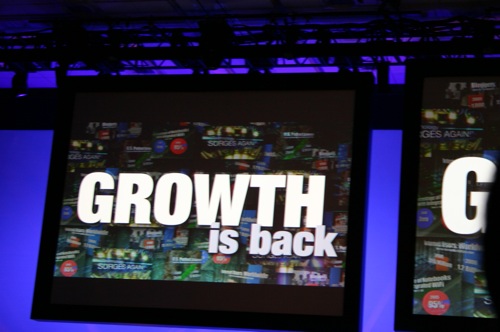
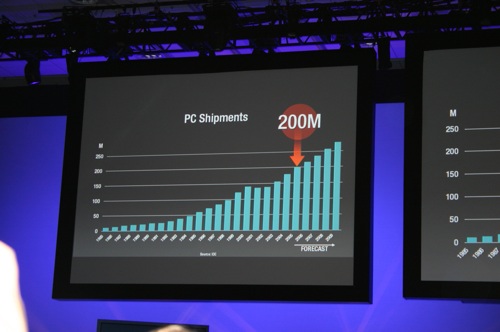

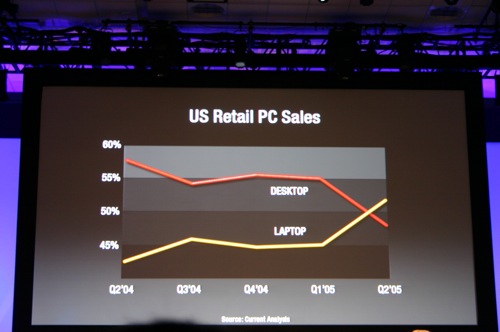
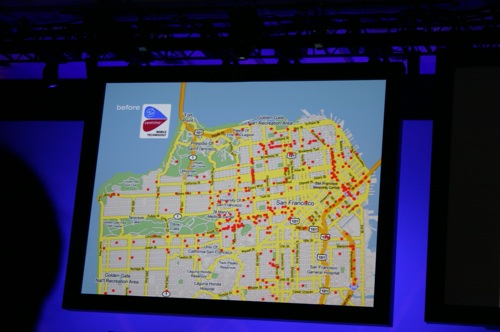
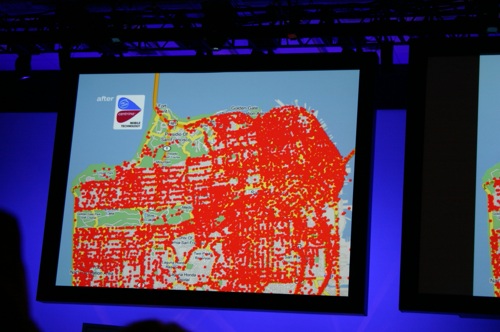








34 Comments
View All Comments
Leper Messiah - Tuesday, August 23, 2005 - link
Shens to no desktop purchases in the next 5 years. I personally plan on having a PC desktop in the next 5 years, and so does most of AT, i'm sure. Schools, businesses, etc., all will have desktops. So yeah.Anyone reminded of the IDF in 2000, when tejas was supposed to have us to 10GHz by now...Basically, I'll believe it when I see it.
bob661 - Tuesday, August 23, 2005 - link
I don't think they're giving that market away. I think Intel is saying that there won't be much money to be made in the desktop market after a while.
xbdestroya - Tuesday, August 23, 2005 - link
Are those future wattage estimates for processor alone, or total system expenditure? Because if it's CPU alone, 65 watts on the desktop is good - but it doesn't seem too mindblowing.xbdestroya - Tuesday, August 23, 2005 - link
I don't know, I think he whole 'per watt' angle is a good way to go, even on the desktop. A lot of people feel this will usher in an era of stylish, small, and quiet desktop PC's. As long as I can still buld my own, I'm all for it. Now then, on the other hand it's true that just because a chip has superior performance per watt, doesn't mean it has superior performance period.Matthew Daws - Tuesday, August 23, 2005 - link
It's interesting that for desktop CPU's they use "Integer" performance, while for servers they use "Relative TPC-C", i.e. a real-world database measurement. This could be nothing, but given that in the past the trend has been to push "media" performance, which generally means floating-point SIMD stuff, it's maybe a significant change. By which I mean: I would guess that this means 5x performance increase per watt doing some rather special, probably very heavy SIMD, integer work.As someone else said, it's odd that they are moving to "per watt" on desktop: it makes sense for laptops, and maybe for servers (heat and power are important) but on the desktop? It almost smacks of a new marketting angle: the new chips won't actually be measurably quicker than current ones, but will use a significant amount less power. Maybe good for business users, but not so great for the Anandtech market!
Jep4444 - Tuesday, August 23, 2005 - link
Does anyone else find this marketing direction(atleast for desktops and servers, it makes sense for laptops) is really stupid?Also i cant trust any diagram that depicts the Prescott as providing more performance per watt than the Northwood because anyone who knows anything about the Prescotts abnormal power requirements knows thats blatantly not true and also makes me highly skeptical about that 5x performance per watt number that Intel is giving
fishbits - Tuesday, August 23, 2005 - link
It doesn't matter. Intel can tell the true believers that it will be 5x as powerful and they'll believe it and buy it before bothering to verify the claims. Then if Intel doesn't live up to the promise, the fanbase will come up with excuses as to why that's no big deal. Me, I'd rather see real numbers from any CPU from Intel or AMD first, but you can already find folks swearing on their family's lives what the new Intel chips will be able to do, what the new ATI gpu will do, etc. It's a sickness, really."On electrical cost savings alone, PC users will save $1 billion per year for every 100M computers."
Ten whole dollars per year? Whoopdee doo!
Yes, lower power is better overall, but it's not the Alpha and Omega of processor value to me, especially in my hobbyist desktop. It just can't be "too hot" or draw "too much power." Hope Intel doesn't lose sight of this, although figuring out where to draw that line can be quite hard to do.
nullpointerus - Tuesday, August 23, 2005 - link
It occurred to me that they may be trying to capitalize on the U.S. fuel pseudocrisis. People will probably buy anything right now if you just tell them it's more efficient. Although, if you do the math (1.0 billion divided by 0.1 billion), Intel is only claiming to save people $10 per PC per year.erinlegault - Tuesday, August 23, 2005 - link
I can't believe anything Intel says at these IDF's.bob661 - Tuesday, August 23, 2005 - link
I just hope this "new" architecture performs better than what's available now.